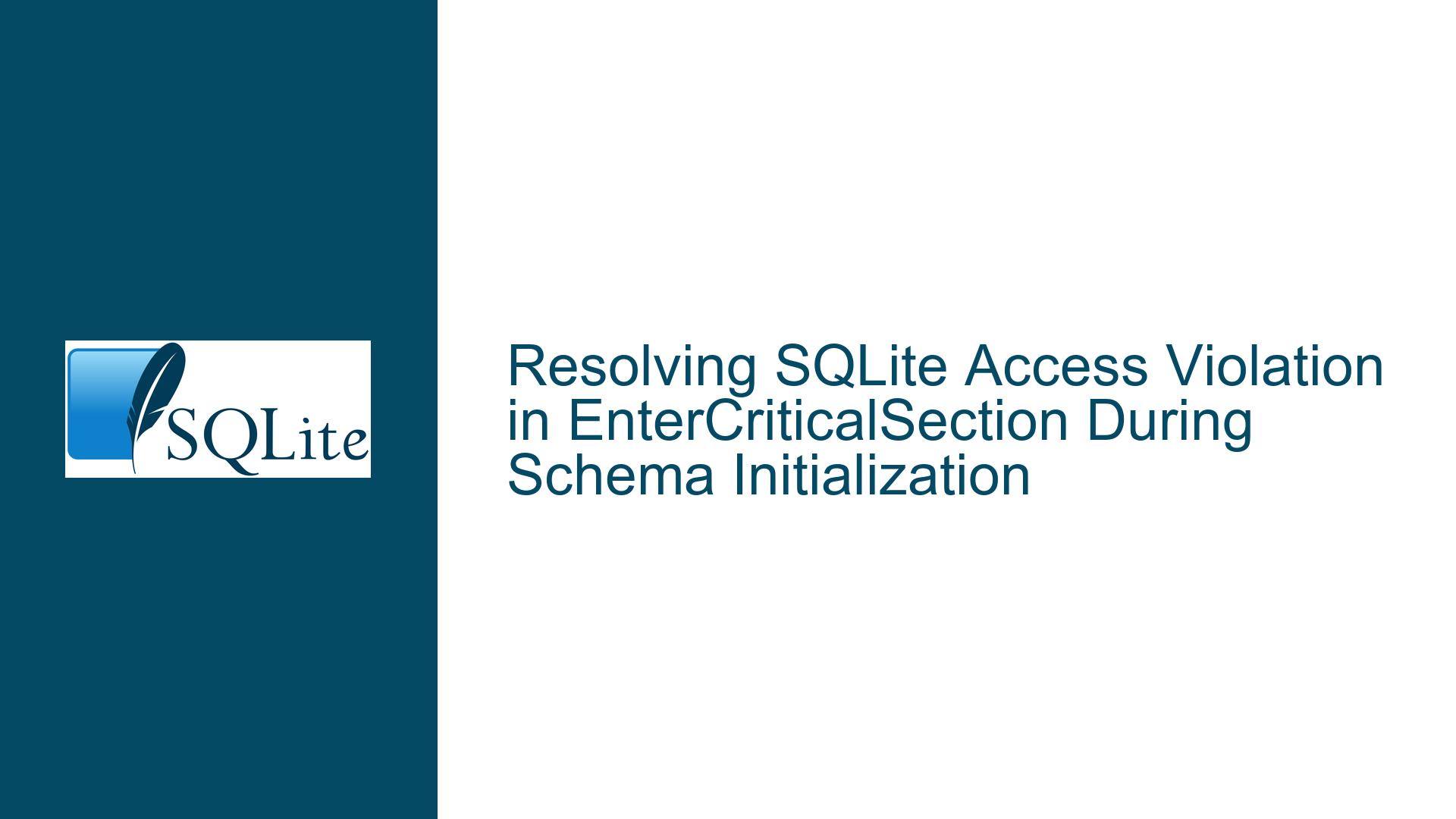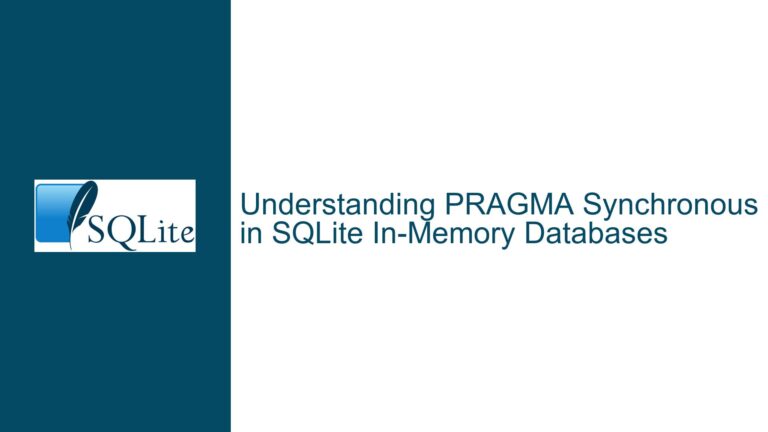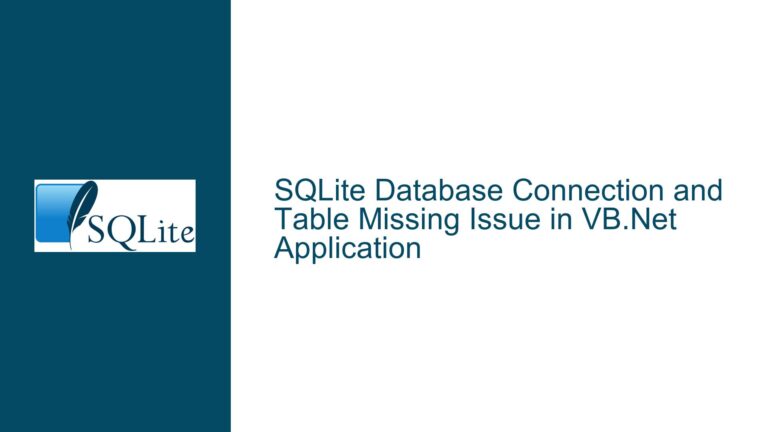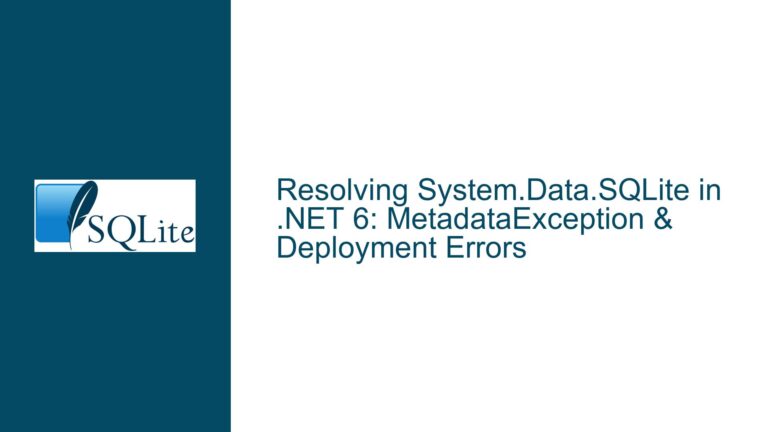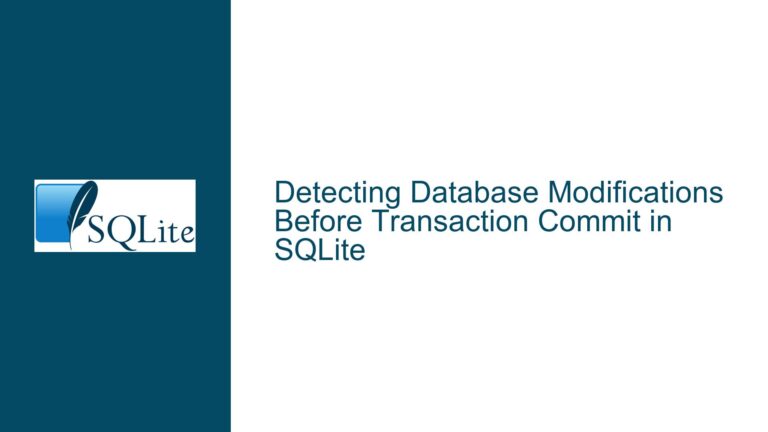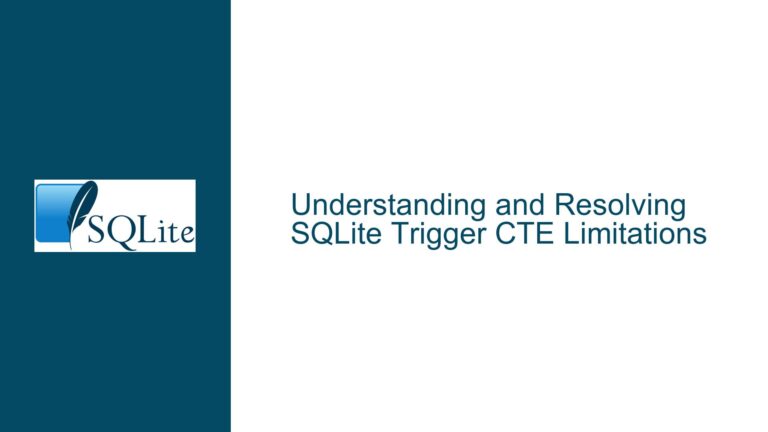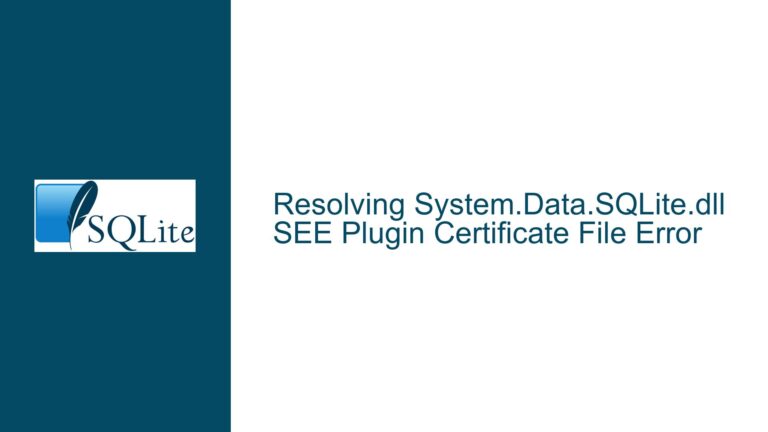Resolving SQLite Access Violation in EnterCriticalSection During Schema Initialization
Critical Section Access Violation During SQLite Table Creation Operations
Issue Overview: Access Violation in RtlEnterCriticalSection with Zero-Initialized Mutex
The problem manifests as an access violation crash in the Windows RtlEnterCriticalSection function when SQLite attempts to acquire a mutex during schema initialization. The crash occurs specifically in the context of sqlite3_prepare_v2, which is invoked during SQLiteConnection.CreateTable or GetTableInfo operations. Analysis of crash dumps reveals that the _RTL_CRITICAL_SECTION structure associated with the mutex contains all-zero values, indicating the critical section was either never initialized, prematurely destroyed, or its memory corrupted.
SQLite relies on mutexes to synchronize access to internal data structures, especially in multi-threaded scenarios. When a thread attempts to enter a critical section that has not been properly initialized (e.g., zeroed memory), the Windows kernel API RtlEnterCriticalSection triggers an access violation. This issue is particularly insidious because it occurs sporadically in production environments without a consistent reproducer, complicating root cause analysis. The call stack points to SQLite’s statement preparation lifecycle, which involves parsing SQL syntax, resolving schema objects, and validating table structures. These operations require acquiring mutexes related to the database connection and schema metadata.
The zero-initialized critical section suggests one of three fundamental failures:
- Mutex Initialization Race Condition: The SQLite library or its wrapper (SQLitePCLRaw) failed to initialize the mutex before it was used, possibly due to thread contention during library initialization.
- Memory Corruption: Heap corruption overwrote the critical section’s memory region, zeroing its fields (e.g.,
LockCount,RecursionCount). - Thread Safety Misconfiguration: SQLite was compiled with thread safety disabled (
SQLITE_THREADSAFE=0), but the application attempts concurrent access.
Possible Causes: Mutex Lifecycle Mismanagement and Concurrency Conflicts
1. Improper SQLite Initialization in Multi-Threaded Environments
SQLite’s thread safety depends on correct initialization of its global mutexes. If the application initializes SQLite or its wrapper library (SQLitePCLRaw) lazily—for example, during the first database connection—a race condition can occur when multiple threads simultaneously trigger initialization. The SQLitePCLRaw bundle_green provider dynamically loads the SQLite native library via P/Invoke, and its initialization logic may not be thread-safe. If two threads attempt to initialize SQLite concurrently, one thread might begin using the mutex before another completes its initialization, resulting in a partially initialized critical section.
2. Heap Corruption Due to Incorrect P/Invoke Signatures or Memory Overwrites
The zeroed critical section could result from memory corruption in the native heap. Common causes include:
- Buffer overflows in SQLite or application code overwriting the critical section’s memory.
- Incorrect disposal of SQLite objects (e.g., closing a database connection while another thread is executing a query).
- Mismatched calling conventions in P/Invoke methods, leading to stack imbalances that corrupt the heap.
3. Use of a Non-Thread-Safe SQLite Build
If the SQLite native library was compiled with SQLITE_THREADSAFE=0, all mutex operations become no-ops. However, attempting to use such a build in a multi-threaded context causes undefined behavior, as SQLite skips mutex initialization entirely. The critical section pointers in SQLite’s mutex structures would remain uninitialized (zeroed), leading to access violations when the application implicitly enables threading.
4. SQLitePCLRaw Bundle or Provider Configuration Issues
The sqlite-net library depends on SQLitePCLRaw for native interop. Older versions of SQLitePCLRaw.bundle_green (prior to 2.0.0) have known issues with thread-safe initialization and provider registration. For example, if the application references multiple SQLitePCLRaw bundles (e.g., bundle_green and bundle_e_sqlite3), the provider might resolve to an incompatible native library version, bypassing proper mutex initialization.
Troubleshooting Steps, Solutions & Fixes: Diagnosing and Resolving Mutex Initialization Failures
Step 1: Validate SQLite Thread Safety Configuration
First, confirm that the SQLite native library in use supports multi-threading. Invoke sqlite3_threadsafe() via P/Invoke and assert that it returns 1 (thread-safe) or 2 (serialized mode). If the result is 0, replace the native library with a thread-safe build.
[DllImport("e_sqlite3", CallingConvention = CallingConvention.Cdecl)]
public static extern int sqlite3_threadsafe();
public void VerifyThreadSafety()
{
int threadsafe = sqlite3_threadsafe();
if (threadsafe == 0)
{
throw new NotSupportedException("SQLite is compiled with SQLITE_THREADSAFE=0");
}
}
Step 2: Update SQLitePCLRaw and Enforce Explicit Bundle Initialization
Ensure all SQLitePCLRaw packages are updated to the latest stable versions. Add an explicit dependency on SQLitePCLRaw.bundle_green (≥2.0.6) to override older transitive dependencies from sqlite-net. During application startup, force-initialize the provider to avoid lazy initialization races:
SQLitePCL.Batteries_V2.Init();
If using a dynamic provider (e.g., bundle_green), switch to a static provider like bundle_e_sqlite3, which links the native SQLite library statically and avoids runtime resolution issues:
// Uninstall SQLitePCLRaw.bundle_green and install SQLitePCLRaw.bundle_e_sqlite3
// No code change needed; the bundle initializes statically
Step 3: Audit Native Library Loading and Initialization Order
Inspect the application’s startup sequence to ensure SQLitePCLRaw initializes before any database operations. Use debug logging to verify that the correct native library is loaded:
SQLitePCL.raw.SetProvider(new SQLitePCL.SQLite3Provider_e_sqlite3());
Console.WriteLine($"SQLite version: {SQLitePCL.raw.sqlite3_libversion()}");
Attach a debugger or use Process Monitor to confirm that the expected e_sqlite3.dll (or equivalent) is loaded from the application directory, not from system paths or unexpected dependencies.
Step 4: Instrument Mutex Initialization and Usage
Recompile SQLite with debugging symbols and trace mutex operations. Download the SQLite amalgamation source, define SQLITE_DEBUG, SQLITE_ENABLE_API_ARMOR, and SQLITE_ENABLE_OVERSIZE_CELL_CHECK, and compile a custom build:
cl -DSQLITE_DEBUG -DSQLITE_ENABLE_API_ARMOR -DSQLITE_ENABLE_OVERSIZE_CELL_CHECK sqlite3.c -link -dll -out:e_sqlite3_debug.dll
Replace the existing native library with this instrumented version. SQLite will now log mutex operations to the console or debug output, helping identify uninitialized mutex usage.
Step 5: Detect Heap Corruption with Application Verifier
Use Windows Application Verifier to monitor the application for heap corruption. Enable checks for Heaps, Handles, and Locks to catch buffer overflows, double-frees, or critical section misuse. Reproduce the crash under AppVerifier to pinpoint the corruption source.
Step 6: Enforce Single-Threaded Schema Initialization
If the crash occurs during CreateTable or GetTableInfo, ensure schema initialization occurs synchronously on a single thread. Wrap schema migration code in a lock statement or use a Lazy<T> pattern to guarantee thread-safe initialization:
private static readonly object SchemaLock = new object();
private static bool _isInitialized = false;
public void InitializeSchema()
{
lock (SchemaLock)
{
if (!_isInitialized)
{
using (var conn = new SQLiteConnection("mydb.sqlite"))
{
conn.CreateTable<MyEntity>();
}
_isInitialized = true;
}
}
}
Step 7: Analyze Crash Dumps for Memory Corruption Patterns
Inspect the crash dump’s heap memory near the zeroed critical section. Look for byte patterns suggesting buffer overflows (e.g., repeated ASCII strings, unusually high pointer values). Use Windbg’s !heap command to validate heap segment integrity:
0:000> !heap -p -a <critical_section_address>
Check for heap block metadata corruption, such as invalid guard bytes or block sizes.
Step 8: Replace SQLitePCLRaw with a Static Native Build
If dynamic provider initialization remains suspect, switch to a fully static build of SQLite. Compile SQLite directly into the application executable or use a precompiled static library like sqlite3.o linked via P/Invoke. This eliminates runtime library loading uncertainties.
Final Fix: Adopt a Thread-Safe Initialization Pattern for SQLite Connections
Ensure all database connections, especially those involved in schema modifications, are instantiated after explicit provider initialization and within thread-safe contexts. Avoid exposing raw SQLiteConnection instances across async/await boundaries without proper synchronization. Consider using a connection pool or a main-thread dispatcher for schema operations.
